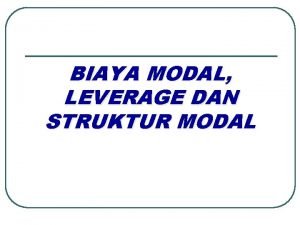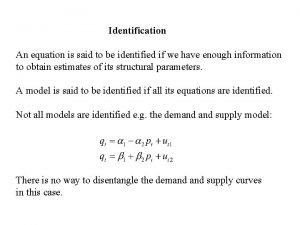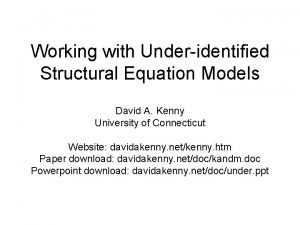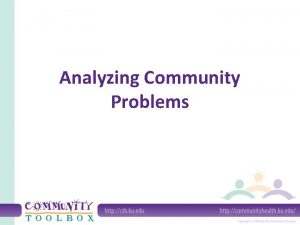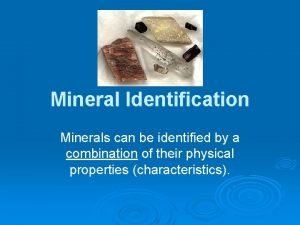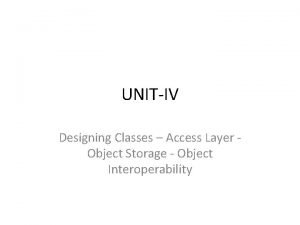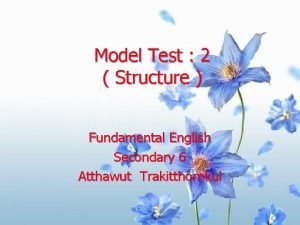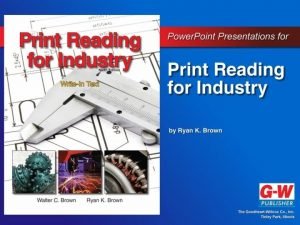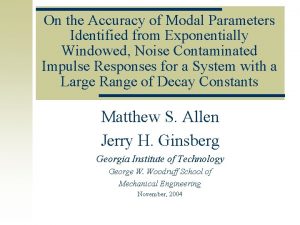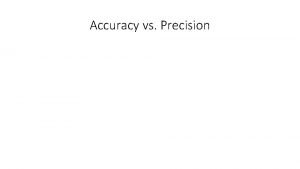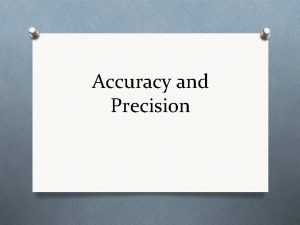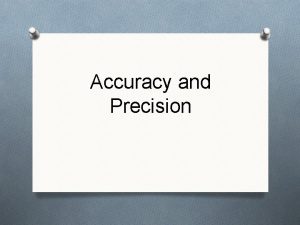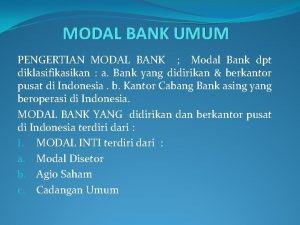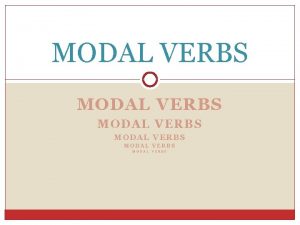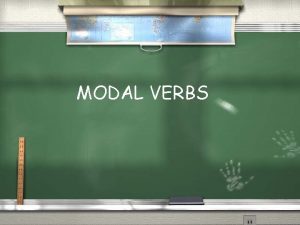On the Accuracy of Modal Parameters Identified from





















- Slides: 21

On the Accuracy of Modal Parameters Identified from Exponentially Windowed, Noise Contaminated Impulse Responses for a System with a Large Range of Decay Constants Matthew S. Allen Jerry H. Ginsberg Georgia Institute of Technology George W. Woodruff School of Mechanical Engineering November, 2004

Outline w Background: n n Introduction to Experimental Modal Analysis Measuring Frequency Response Functions l n n Persistent vs. Impulsive Excitations Difficulties in testing a system with a range of decay constants in the presence of noise. Exponential Windowing w Experiment: Noise contaminated data n Effect of exponential window on accuracy w Conclusions 2

Experimental Modal Analysis w A Linear-Time-Invariant (LTI) system’s response is a sum of modal contributions. F n n n … r r f r Natural Frequency Damping Ratio Mode Vector (shape) In EMA we seek to identify these modal parameters from response data. 3

EMA Applications w Applications of EMA n n n n Validate a Finite Element (FE) model Characterize damping Diagnose vibration problems Simulate vibration response Detect damage Find dynamic material properties Control design … 4

EMA Theory – Measuring FRFs U H( ) Y w Two common ways of measuring the Frequency Response n n H( ) FFT Periodic or Random Excitation Impulse Excitation. w Impulse method is often preferred: + Doesn’t modify the structure + Cost + High force amplitude - Noisy Data 5

Range of Decay Constants: ( r r) Response + Noise + 6

Range of Decay Constants: ( r r) Early Response Fast Slow Noise + + Late Response w Noise dominates the response of the quickly decaying modes at late times. 7

Range of Decay Constants: ( r r) Slow Fast + Noise + 8

Exponential Windowing w Exponential Windows (EW) are often applied to reduce leakage in the FFT. w Effect on modal parameters: n n Adds damping – (can be precisely accounted for) Other windows (Hanning, Hamming, etc…) have an adverse effect. w An EW also causes the noise to decay, reducing the effect of noise at late times. w Could this result in more accurate identification of the quickly decaying modes? 9

Range of Decay Constants Frame Structure w Prototype System: n n Modes 7 -11 have large decay constants. The FRFs in the vicinity of these modes are noisy. 10

Windowing Experiment Noisy Data FFT Window AMI Modal Parameters w Apply windows with various decay constants to noise contaminated analytical data. w Estimate the modal parameters using the Algorithm of Mode Isolation (JASA, Aug-04, p. 900 -915) w Evaluate the effect of the window on the accuracy of the modal parameters. w Repeat for various noise profiles to obtain statistically meaningful results. 11

Sample Results: Damping Ratio Standard Deviation Mean w Two distinct phenomena were observed. n n Increase in scatter – (Lightly damped modes. ) Decrease in bias – (Heavily damped modes. ) w These are captured by the standard deviation and mean of the errors respectively. 12

w Largest errors were the bias errors in modes 8 -11. w These decreased sharply when an exponential window was applied. % Scatter in Damping Ratio % Bias in Damping Ratio Results: Damping Ratio 13

Results: Natural Frequency 14

Noise Level vs. Exponential Factor w Bias errors are related to the Signal to Noise Ratio. n Bias is small when the signal is 20 times larger than the noise. w SNR attains a maximum when the window factor equals the modal decay constant. 15

Conclusions w Exponential windowing improves the SNR of the FRFs in the vicinity of each mode, so long as the window factor is not much larger than the modal decay constant. w Damping Ratio: n Bias Errors in the damping estimates are small so long as the SNR is above 20 (see definition. ) w Natural Frequency: n EW has a small effect so long as the exponential factor is smaller than the modal decay constant. w Similar Results for Mode Shapes & Modal Scaling. 16

Questions? 17

Results: Damping Ratio % Bias in Damping Ratio n n n Exponential windowing did not decrease the scatter significantly for modes 8 -11. The scatter for modes 1 -7 increased sharply for large exponential factors. Exponential factors as large as the modal decay constant could be safely used. % Scatter in Damping Ratio w Observations: 18

EMA Theory w Equation of Motion w Frequency Domain w Two common ways of measuring the Frequency Response n w Modal Parameters Apply a broadband excitation and measure the response. Apply an impulsive excitation and record the response until it decays. 19

Effect of Exponential Window on SNR Increasing Damping w Damping added by the exponential window decreases the amplitude of the response in the frequency domain. w The amplitude of the noise also decreases. w The net effect can be increased or decreased noise. 20

Range of Decay Constants: ( r r) Early Response + Slow + Fast Noise Late Response w Noise dominates the response of the quickly decaying modes at late times. w A shorter time window reduces the noise in these modes, though it also results in leakage for the slowly decaying modes. 21
 Modal adalah dalam akuntansi
Modal adalah dalam akuntansi Difference between modals and semi modals
Difference between modals and semi modals Berapa modal
Berapa modal Akaun untung rugi perkongsian
Akaun untung rugi perkongsian Rekod tak lengkap format
Rekod tak lengkap format This is one of the identified reasons why
This is one of the identified reasons why Identified motivation
Identified motivation Identified equation
Identified equation Identified patient
Identified patient Under identified model
Under identified model An uncontrolled railroad crossing usually has *
An uncontrolled railroad crossing usually has * Sdt motivation continuum
Sdt motivation continuum The organelle identified in the picture as #10
The organelle identified in the picture as #10 Identified community problem
Identified community problem Drag the example to connect with the description given
Drag the example to connect with the description given Define luster in minerals
Define luster in minerals Pictograms can be easily identified because they have a
Pictograms can be easily identified because they have a Dash classes identified during access layer design
Dash classes identified during access layer design Non linear multimedia
Non linear multimedia Create user username identified by password
Create user username identified by password As many as 1000 species of finch have been identified
As many as 1000 species of finch have been identified Why drawing was identified as the language of industry
Why drawing was identified as the language of industry


